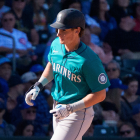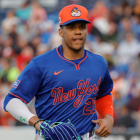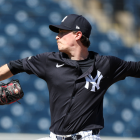The 2019 Major League Baseball regular season is four full days old and 2.2 percent complete. There is still a lot -- a lot -- of baseball to be played, so I wouldn't fret just yet Astros, Red Sox, and Yankees fans. Something tells me those teams won't continue on their 100-loss paces.
Although the season remains very young, it is not too early to examine some league-wide trends. There have already been over 4,000 plate appearances this season. Those plate appearances can tell us things about the state of baseball and where the game might be heading. Baseball is always evolving and it's never too early to take notice.
Here are a few league-wide trends from the early days of the 2019 season that are worth keeping an eye on going forward.
Strikeouts are still on the rise
| Year | First Four Days | Final Regular Season Numbers |
|---|---|---|
2015 | 21.8 K% and 7.6 BB% | 20.4 K% and 7.7 BB% |
2016 | 22.6 K% and 8.1 BB% | 21.1 K% and 8.2 BB% |
2017 | 22.4 K% and 9.3 BB% | 21.6 K% and 8.5 BB% |
2018 | 22.1 K% and 9.3 BB% | 22.3 K% and 8.5 BB% |
2019 | 23.2 K% and 9.4 BB% | -- |
Compared the first four full days of 2017 and 2018, the league-wide walk rate has held relatively steady, and we can expect it to drop a tad come the end of the regular season. Walks are up early mostly because pitchers aren't quite in midseason form yet, and also because many pitchers and catchers are working together for the first time. That sort of thing.
As for strikeouts, MLB has set a new record high strikeout rate in nine of the last 10 seasons, and the league is on pace to set another record in the early days this year. The league average strikeout rate is up a full percentage point from the same period last season and more than two full percentage points from 2015. We are gradually approaching a point where one out of every four plate appearances will end with strike three.
MLB's head honchos are concerned about the decline in balls in play, so much so that they are experimenting with moving the mound back two feet in the independent Atlantic League to see whether it increases contact rates. That is an extreme solution and, frankly, we don't know whether it is a solution at all. It's a theory. Regardless, the strikeout rate arrow is firmly pointed up and I see no reason to believe that will change anytime soon.
The 'launch angle revolution' is alive and well
| Year | First Four Days | Final Regular Season Numbers |
|---|---|---|
2015 | 45.0 GB% and 35.4 FB% | 45.3 GB% and 33.8 FB% |
2016 | 43.9 GB% and 34.5 FB% | 44.7 GB% and 34.6 FB% |
2017 | 44.8 GB% and 35.8 FB% | 44.2 GB% and 35.5 FB% |
2018 | 40.4 GB% and 38.4 FB% | 43.2 GB% and 35.4 FB% |
2019 | 41.6 GB% and 38.5 FB% | -- |
This is tied to the rising strikeout rate and it's a chicken or the egg question. Are strikeouts up because players are getting too fly ball and home run happy, thus altering their swings and approaches? Or are fly balls up because strikeouts are up, and players are trying to hit home runs because stringing together base hits to build a rally is more difficult than in the past?
Either way, the so called "launch angle revolution" hasn't slowed down. Ground balls are actually up more than a full percentage point from the same period last season, though they are way down from two years ago. The league fly ball rate is way up from two years ago. Through four full regular season days, there are considerably fewer ground balls and more fly balls than during the same period just two years ago.
Not coincidentally, home runs are up through the first four full days of the season as well:
- 2019: 1.3 HR/9
- 2018: 1.1 HR/9
- 2017: 1.1 HR/9
- 2016: 1.2 HR/9
- 2015: 0.8 HR/9
With home runs, the great unknown is the baseball itself. Research supports the theory that physical changes to the baseball have resulted in an uptick in home runs in recent years. The changes to the baseball are not necessarily nefarious -- the ball's specifications still fall within the league's standards -- but there has been a change to the ball and a corresponding uptick in home runs. Maybe the ball changed against this season. We don't know.
At the same time, hitters are altering their swings and approaches, and they are trying to get the ball airborne as often as possible. Good things happen when you hit the ball hard and you hit the ball in the air, and hitters are doing it more often now than at any point in the last few years, and maybe even at any other point in baseball history. There are no signs this trend will slow down soon.
The 'anti-fastball' philosophy is catching on
| Year | First Four Days | Final Regular Season Numbers |
|---|---|---|
2015 | 52.8% fastballs | 52.6% fastballs |
2016 | 53.0% fastballs | 52.0% fastballs |
2017 | 53.9% fastballs | 53.6% fastballs |
2018 | 51.7% fastballs | 51.8% fastballs |
2019 | 49.1% fastballs | -- |
This is a fascinating one. There is more velocity in baseball than ever before. Modern training methods have proven to be very effective at building arm strength. Five years ago the average fastball velocity was 92.1 mph. Ten years ago it was 91.4 mph. This season? The average fastball velocity through four full days is 92.9 mph.
And yet, even with all that velocity, teams have reduced their fastball usage the last few years. They have all this big velocity and they're saying nah, we're not going to use it as often. Why? Because pitches that move are much harder to hit. The 2016-18 league averages:
- vs. Fastballs: .272 batting average and .454 slugging percentage
- vs. Breaking Balls: .215 batting average and .355 slugging percentage
- vs. Offspeed: .237 batting average and .391 slugging percentage
MLB pitchers are not ignoring the increase in fastball velocity. They're still using it to their advantage. The extra velocity makes it that much more difficult to adjust to slower breaking balls and offspeed pitches. Hitters have to respect the heater. Drop in a curveball or changeup and pitchers tend to get better results.
The Astros and Yankees were at the forefront of this "anti-fastball" philosophy. They scaled back their fastball usage a few years ago and hey, the Astros won a World Series doing it. Other teams have since caught on and it is now at the point where, through four days and 958 2/3 innings this season, fewer than 50 percent fastballs have been thrown. That is bonkers.
Over the last few years the final regular season fastball usage rate corresponded very closely to the fastball usage rate during the first four full days of the season. Could it be that more breaking balls and offspeed pitches will be thrown than fastballs this year? Yes, it is very possible, and even if it doesn't happen in 2019, the trend suggests it isn't far off.

















